Sirmione and the Grottoes of Catullus
At the tip of a peninsula that juts out into Lake Garda’s southern shoreline, are the medieval town of Sirmione, Scaligero Castle, and the ruins of a Roman villa dating back to the end of the first century BC – the Grottoes of Catullus.
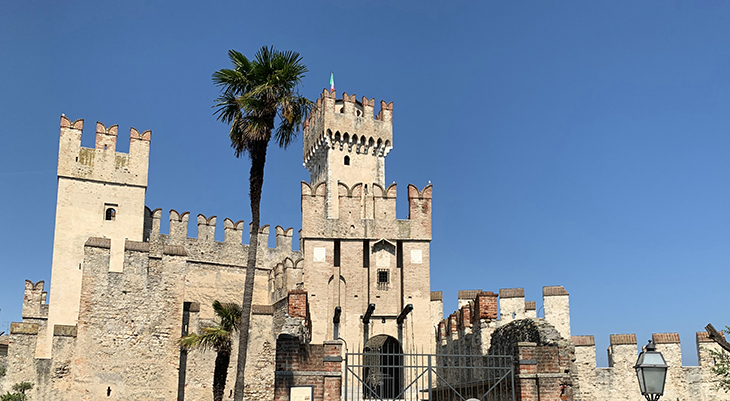 (Scaligero Castle, Sirmione, Lake Garda, Italy Photo: © 2019 Anita Hamilton)
(Scaligero Castle, Sirmione, Lake Garda, Italy Photo: © 2019 Anita Hamilton)
We recently enjoyed a 10-day tour of Northern Italy with Insight Vacations. Our tour began in Milan and took us to historic cities such as Bolzano, Trento and Venice, circling back around to the Italian Lakes District encompassing Lake Como, Lake Garda, Lake Maggiore and Lake Orta. Before our bus pulled into the town of Sirmione I had never heard of it…now I understand why it’s been considered a hidden jewel.
Old Sirmione and Catullus
Settlements on stilts (palafitte) existed in the Sirmione area of Lake Garda back in the 2000s-1000s BC.
The Roman poet Catullus (c. 84 BC – 54 BC), whose family was among the wealthy vacationers from nearby Verona who kept a villa here, references Sirmione in his homecoming poem, Catullus 31. There have been many attempts at translating his verse from the original Latin over the centuries.
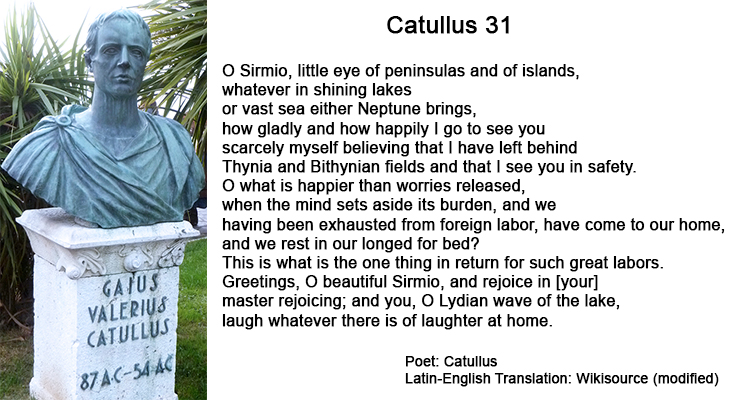 (Catullus Bust at Sirmione 2013 Photo: JoJan)
(Catullus Bust at Sirmione 2013 Photo: JoJan)
Note: Thynia and Bithynia were ancient names for locations on the respective north and south sides of the Propontis, an inland sea (today it’s the Sea of Marmara in Turkey).
Today Sirmione is a popular resort town, situated as it is on Italy’s largest lake, Lake Garda. It’s still got many of the medieval 13th century buildings, now converted into shops and restaurants, and Scaligero Castle.
New Sirmione and the “old town” of Sirmione are accessed by a walkway that goes over the Scaligero Castle moat.
 (Old Sirmione and Scaligero Castle from Lake Garda 2017 Photo: Diego Bonacina)
(Old Sirmione and Scaligero Castle from Lake Garda 2017 Photo: Diego Bonacina)
This section of the peninsula see above, encompassing Scaligero Castle, the old town of Sirmione, and the Grottoes of Catullus, is completely surrounded by water.
On the “new” side of the moat, views of Lake Garda’s marina, pink bougainvillea and plane trees with their distinctively mottle trunks, abound.
 (Plane Trees & Pink Bougainvillea Flowers, Sirmione, Lake Garda, Italy Photos: © 2019 Anita Hamilton)
(Plane Trees & Pink Bougainvillea Flowers, Sirmione, Lake Garda, Italy Photos: © 2019 Anita Hamilton)
The streets of the old town of Sirmione are shaded by colorful historic buildings.
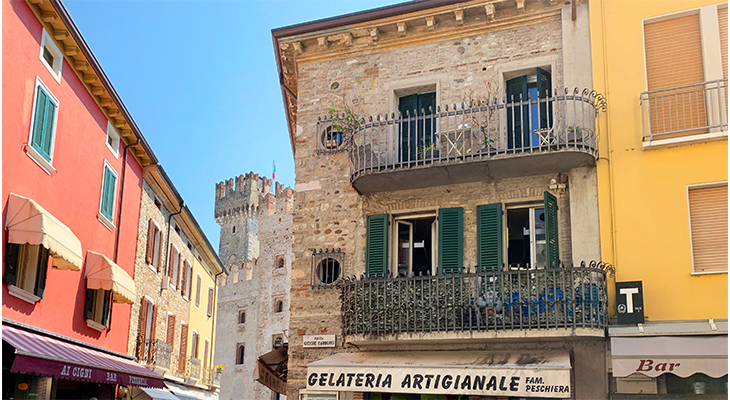 (Old Sirmione Buildings, Lake Garda, Italy Photo: © 2019 Anita Hamilton)
(Old Sirmione Buildings, Lake Garda, Italy Photo: © 2019 Anita Hamilton)
We took a break from walking around to cool off and enjoy a delicious pasta lunch at Il Girasole restaurant while we people-watched other tourists.
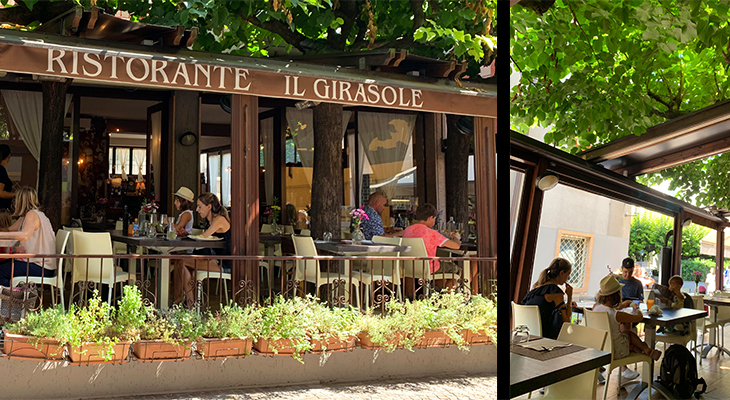 (Il Girasole Restaurant, Sirmione, Lake Garda, Italy Photos: © 2019 Anita Hamilton)
(Il Girasole Restaurant, Sirmione, Lake Garda, Italy Photos: © 2019 Anita Hamilton)
This charming restaurant has a section opening onto the street, that is completely shaded by a leafy tree.
Flowers abound on top of rock walls, town buildings, and castle walkway walls through the town.
 (Sirmione Bougainvillea and Other Flowers, Lake Garda, Italy Photos: © 2019 Anita Hamilton)
(Sirmione Bougainvillea and Other Flowers, Lake Garda, Italy Photos: © 2019 Anita Hamilton)
Della Scala Medieval Scaligero Castle
A moat separates medieval Scaligero Castle and the “old town” of Sirmione from mainland Italy. You can only enter the castle by a drawbridge (there are two of them.) Fortification walls extend out into Lake Garda for this sea port.
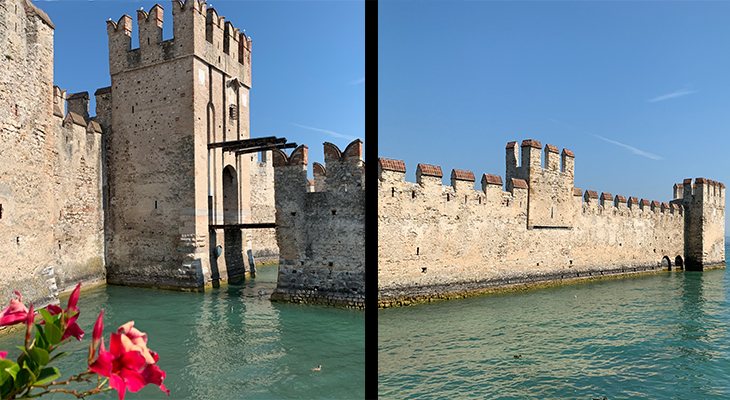 (Scaligero Castle, Moat & Fortification Walls, Sirmione, Lake Garda Photos: © 2019 Anita Hamilton)
(Scaligero Castle, Moat & Fortification Walls, Sirmione, Lake Garda Photos: © 2019 Anita Hamilton)
The Della Scala family who ruled Verona and this area of Lake Garda from the 1200s-1300s, began building Scaligero Castle c. 1277. Today there’s a small museum inside, with local medieval and Roman artifacts.
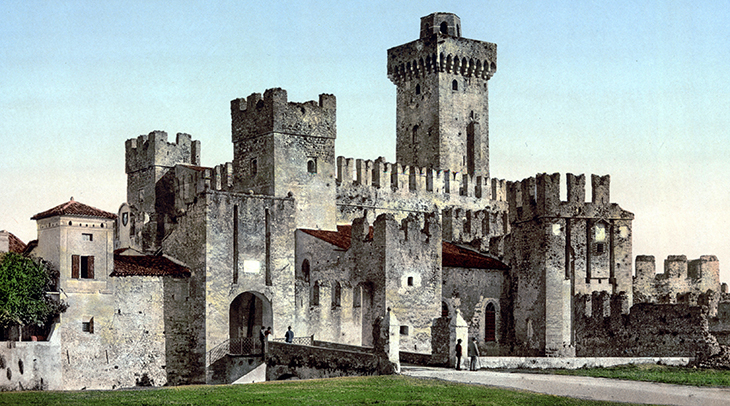 (Scaligero Castle 1900 Photo: US Library of Congress)
(Scaligero Castle 1900 Photo: US Library of Congress)
Scaligero Castle hasn’t changed significantly in the past 120 years, but there has been significant development of the area in front of the castle on the mainland.
There are several castles around Lake Garda. On the western side of the lake are the 10th century Castello di Moniga, and Padenghe Castle (built c 1145).
The Della Scala family established three other castles / fortresses along the shores of Lake Garda. At the furthest south-eastern point of Lake Garda is the fortified Roman city of Peschiera del Garde and Scaliger fortress, built by the Della Scala family in the 1300s.
North of Sirmione and Scaligero Castle, on the eastern shores of Lake Garda, are two more Della Scala castles – Castello Scaligero in Torri del Benaco, and Castello Scaligero di Lazise. The castle in the town of Torri del Benaco was built in 1338 and is now a museum. The castle of Lazise has existed as a fortified village since the 9th century; the Della Scala family gained control of the area in approximately 1200 and several castle renovations were done by them in the 1300s.
Grottoes of Catullus
We take a “train” ride to the very tip of the peninsula, to see the Grotte di Catullo / Grottoes of Catullus. Just outside the entrance to the Grottoes of Catullus, there is a park named for famed Greek opera singer Maria Callas, who used to have a villa here in Sirmione.
Archeological surveys have indicated this Roman villa was built around the last decades of the 1st century BC to the first decades of the 1st Century AD. The villa was likely abandoned during the 200s AD.
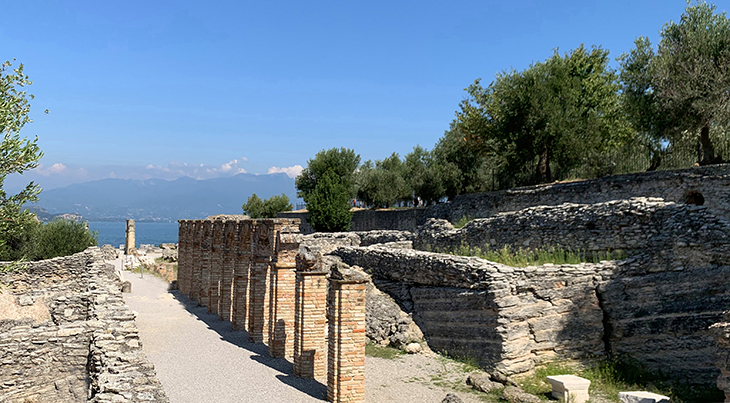 (Grottoes of Catullus Cryptoportico of Stuccos & Lake Garda, Sirmione Photo: © 2019 Anita Hamilton)
(Grottoes of Catullus Cryptoportico of Stuccos & Lake Garda, Sirmione Photo: © 2019 Anita Hamilton)
After exiting the Grottoes of Catullus museum, we walk down a long path with olive trees on one side and an ancient defence wall, erected long after the villa was no longer in active use, probably from around 300-400 AD.
 (Grottoes of Catullus Defence Wall at Lake Garda, Sirmione, Italy Photo: © 2019 Anita Hamilton)
(Grottoes of Catullus Defence Wall at Lake Garda, Sirmione, Italy Photo: © 2019 Anita Hamilton)
It’s very peaceful and quiet here, unlike the busy streets of Sirmione’s old town. The villa had three floors, supported by powerful substructures made of bricks and limestone.
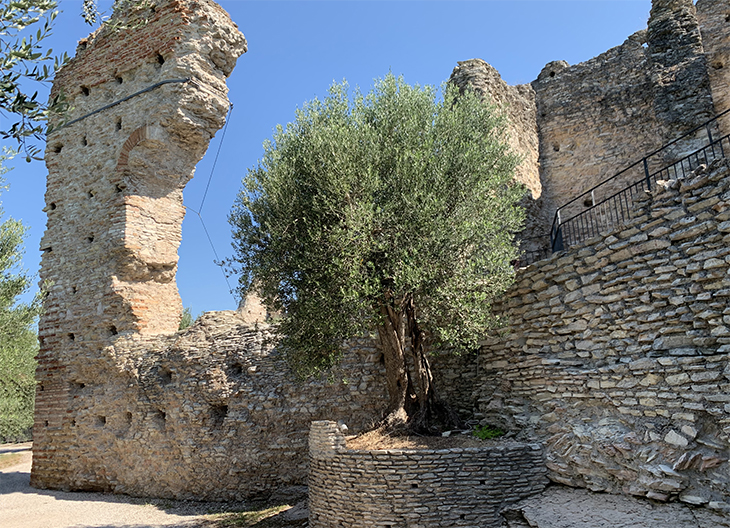 (Grottoes of Catullus Grande Pilon at Lake Garda, Sirmione, Italy Photo: © 2019 Anita Hamilton)
(Grottoes of Catullus Grande Pilon at Lake Garda, Sirmione, Italy Photo: © 2019 Anita Hamilton)
Near the entrance to the villa is the remnant of a foundation wall called the grande pilone, and beyond that is the “Hall of Giants”.
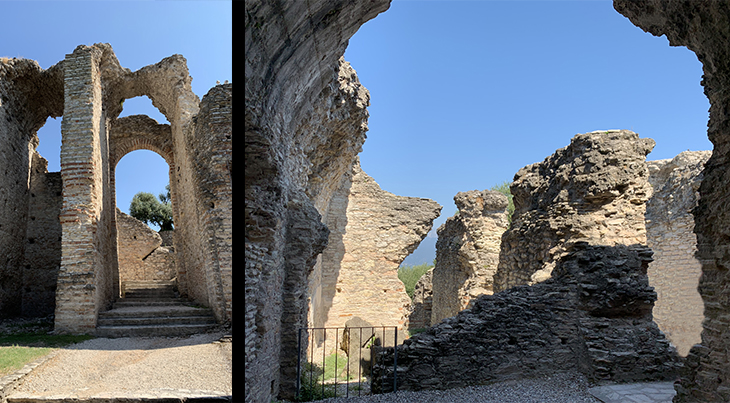 (Grottoes of Catullus Hall of Giants Montage, Sirmione, Lake Garda Italy Photo: © 2019 Anita Hamilton)
(Grottoes of Catullus Hall of Giants Montage, Sirmione, Lake Garda Italy Photo: © 2019 Anita Hamilton)
You can walk through the entire remains of the villa, which had many public rooms, private bedrooms, patios, gardens, etc.
All of the statues and decorations which would have adorned the villa and grounds were removed over the succeeding centuries.
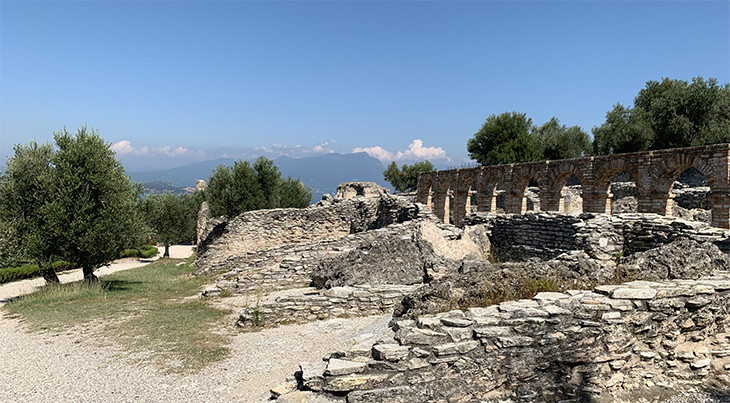 (Grottoes of Catullus Cryptoportico of Stuccos & Lake Garda, Sirmione, Italy Photo: © 2019 Anita Hamilton)
(Grottoes of Catullus Cryptoportico of Stuccos & Lake Garda, Sirmione, Italy Photo: © 2019 Anita Hamilton)
The Archaelogical Museum of Sirmione brochure says the cryptoportico above would mostly likely have been a service passage to transport firewood and coal to the villa’s huge thermal bath system and large pool, which would have been heated by a boiler circulating hot air around the sides and under the floor of the pool. A heated pool, a modern-day luxury enjoyed by vacationing Romans in 100-200 AD.
The name “Grottoes of Catullus” dates to the 15th century. It’s possible but unlikely that this was the villa belonging to the poet Catullus, whose family had a villa in Sirmione (possibly this same villa but that’s impossible to prove), paid homage to Sirmione in his poetry before he died in 54 BC. The villa could have belonged to any wealthy family of the time, as it was a popular vacation spot for land-locked Verona inhabitants.
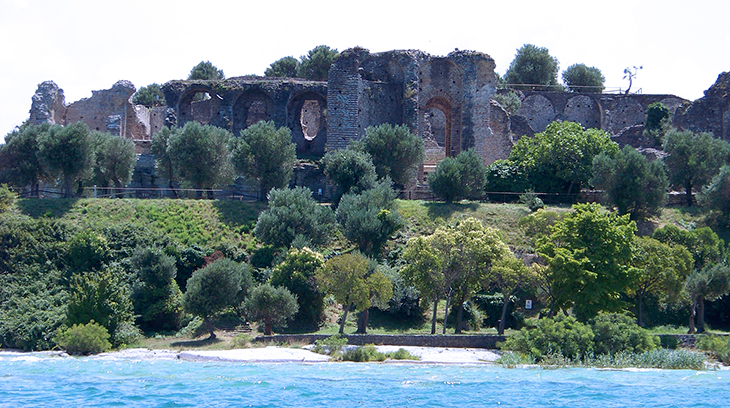 (Grottoes of Catullus from Lake Garda, Italy 2009 Photo: Eleiezzi)
(Grottoes of Catullus from Lake Garda, Italy 2009 Photo: Eleiezzi)
Other highlights of our bus tour include Burano and the Venetian Lagoon, seeing the magnificent Dolomites, a prosecco wine tasting, and visiting the Borromeo Summer Palace “Isola Bella” , and Venice landmarks such as St. Mark’s Square.
If you enjoyed this article you may also like my account of our time in Italy before the tour began. We toured Florence, the Pitti Palace, Cinque Terre and Monterosso al Mare – all unique experiences that helped make this a dream vacation to Italy.
Movies filmed at Sirmione, Scaligero Castle, and / or Lake Garda
The Gamble / La Partita (1988), a historical comedy starring Matthew Modine and Jennifer Beals. The Gamble was filmed at Notre Dame in Paris (France), and several locations in Northern Italy including Sirmione, Castellaro Lagusello, and Mantua in Lombardy; Verona, and Venice.
Miss Arizona (1988), a WWII historical musical-drama starring Marcello Mastroianni and Hanna Schygulla. Filming took place for Miss Arizona at several Sirmione and several nearby spots – Castellaro Lagusello, San Martino della Battaglia, and Solferino.
The Battle of the Villa Fiorita / Affair at the Villa Fiorita (1965), based on Rumer Godden’s 1963 romance novel The Battle of the Villa Fiorita. Filmed at Lake Garda, The Battle of the Villa Fiorita stars Maureen O’Hara, Rossano Brazzi, Richard Todd, and Olivia Hussey.
Quantum of Solace (2008), a James Bond thriller starring Daniel Craig, with Judi Dench, Giancarlo Giannini, and Jeffrey Wright. In addition to film locations in England, Chile, Austria, Panama, Mexico, Spain (Madrid), and several locations/provinces in Northern Italy – Tuscany (Carrara & Siena), Veneto (Verona), and Lombardy (Lake Garda) were used. Daniel Craig drives Bond’s Aston Martin on the roads and tunnels around Lake Garda.
The International (2009), a thriller starring Clive Owen, Naomi Watts, and Armin Mueller-Stahl. The International was filmed in Germany (Berlin & Wolfsburg), U.S.A. (New York), Turkey (Istanbul), France (Lyon), and Italy (Lake Garda & Milan).
*This article is for general informational purposes only. 50+ World does endorse any providers, nor does it receive remuneration from them.*
**Unless indicated otherwise, photographs & text in this article are © 2019 Anita Hamilton. All rights reserved. Do not download or reproduce without written permission. Other images are either presumed to be in the public domain and/or creative commons licensed and sourced via Wikimedia Commons or Flickr**
